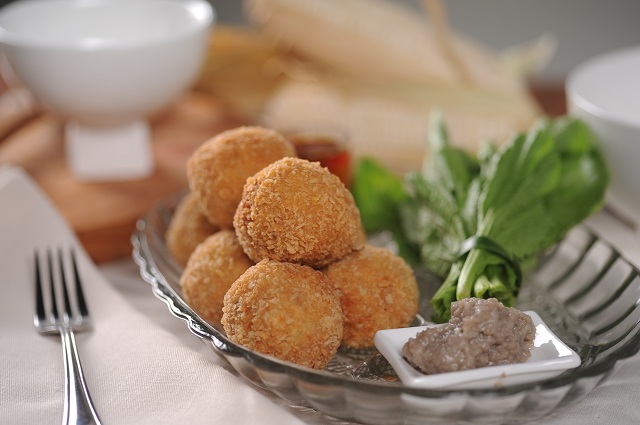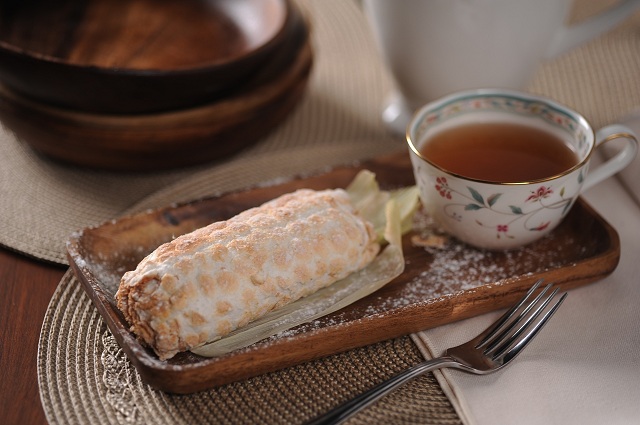ADVERTISEMENT
Filtered By: Lifestyle
Lifestyle
Soul food: Pinác plates up Pampanga's best heritage cuisine
Text and photos by MAX IGNACIO

The Kapampangan take on the arroz valenciana: the bringhe.
Imagine this: Kubyertos clacking, families having hearty conversations, and the hypnotizing aroma of sweet atchara and buro.
This is a typical snapshot of a restaurant in Pampanga—a scenario that’s definitive to Kapampangans because only they can breathe this much life into dining. The Pampangueños have mastered the art of turning their rich culture into something palatable—a delicacy that many find worth traveling for. Genuine Kapampangan cuisine usually takes a two-hour drive if you’re coming from the metro, but thankfully for us Manileños, Pinác Restaurant is conveniently calling Manila home.
Nestled in the newly inaugurated U.P. Town Center on Katipunan Ave., Diliman, Quezon City is Pinác Heirloom Capampangan Cuisine, a restaurant that’s just pulsating with genuine Kapampangan comfort food.
The word Pinác is Kapampangan for farmland or swamp, a tribute to where most of the restaurant’s ingredients come from. Pampanga’s swamplands have an abundance of produce such as watermelons and a variety of freshwater seafood such as ulang (freshwater lobster), tilapia, hito, and dalag. Pinác’s main dishes are centered on these fresh ingredients.
 Among their must-tries are Crispy Hito Balls, Mustasa at Buro (a fried bite-sized concoction filled with shredded catfish then served with mustasa leaves for wrapping and salty-sour buro for dipping), Lumpiang Ubod Taquitos (julienned hearts of palm mixed with shrimp, shiitake mushrooms, beans, and carrots on a bed of fried wontons then drizzled with light peanut sauce) and their Crispy Pata (pork knuckles poached in their own house blend marinade for six hours then deep-fried into crispy perfection, served with homemade Kapampangan atsara).
Among their must-tries are Crispy Hito Balls, Mustasa at Buro (a fried bite-sized concoction filled with shredded catfish then served with mustasa leaves for wrapping and salty-sour buro for dipping), Lumpiang Ubod Taquitos (julienned hearts of palm mixed with shrimp, shiitake mushrooms, beans, and carrots on a bed of fried wontons then drizzled with light peanut sauce) and their Crispy Pata (pork knuckles poached in their own house blend marinade for six hours then deep-fried into crispy perfection, served with homemade Kapampangan atsara).
Their broad dining tables welcome feasting in groups, “Our portions are for sharing,” says Pinác owner Angel Pelayo-Ty. “We wanted to recreate an old Kapampangan dining room because we want families and friends to feel as if they were dining at home.”
This desire to bring a sense of “family” to dining is the very thrust of Pinác. In fact, many of their recipes were passed down from their own lolas. “Pinác’s taste profile was inspired by two of our family’s best cooks: my grandmother and my mom. Our bestsellers include Tidtad, Patatim, and Sinigang na Bangus sa Bayabas, which are all my grandmother’s recipes. On the other hand my mom, who was born in Manila, introduced new techniques of preparing traditional Kapampangan dishes,” she says.
 Pinác’s dishes reflect an uncanny technique, one that can only be perfected through generations of upkeep and reinvention. Each dish reflects its authentic Kapampangan roots but also infuses a modern twist to the palate. Such stellar candidates are the Pocherong Dalag (mudfish with tomato sauce, saba, potatoes and cabbage) and Bapang Medic’s Palaisdaan (grilled fish, blanched vegetables and burong asan)—all brave must-tries for the otherwise inexperienced Manileño tongue.
Pinác’s dishes reflect an uncanny technique, one that can only be perfected through generations of upkeep and reinvention. Each dish reflects its authentic Kapampangan roots but also infuses a modern twist to the palate. Such stellar candidates are the Pocherong Dalag (mudfish with tomato sauce, saba, potatoes and cabbage) and Bapang Medic’s Palaisdaan (grilled fish, blanched vegetables and burong asan)—all brave must-tries for the otherwise inexperienced Manileño tongue.
To cap off this transporting experience, Pinác’s overall ambience is one to equally enjoy. Their chairs come straight from Pampanga—ornate wood and abaca combinations that add to the rustic feel of the place. Hanging from the ceiling are artfully crafted birdcages—an ode to the different species of birds that flock to Pampanga every season. And Spanish-style wooden rails lend a little bit of “country” to the otherwise modern-Filipino décor.
A step inside Pinác is a sensorial journey—great tasting food, appetizing smells, visually stunning dishes, plus a feeling of “family” each time you dine. Pinác successfully brings together the charm of Pampanga, its cuisine, and a Pinoy sense of coming together.
Next time you feel like wolfing down some authentic Kapampangan cuisine, there’s no need to venture two hours up north. At Pinác, you get the real thing sans the long haul. — BM, GMA News
This is a typical snapshot of a restaurant in Pampanga—a scenario that’s definitive to Kapampangans because only they can breathe this much life into dining. The Pampangueños have mastered the art of turning their rich culture into something palatable—a delicacy that many find worth traveling for. Genuine Kapampangan cuisine usually takes a two-hour drive if you’re coming from the metro, but thankfully for us Manileños, Pinác Restaurant is conveniently calling Manila home.
Nestled in the newly inaugurated U.P. Town Center on Katipunan Ave., Diliman, Quezon City is Pinác Heirloom Capampangan Cuisine, a restaurant that’s just pulsating with genuine Kapampangan comfort food.
The word Pinác is Kapampangan for farmland or swamp, a tribute to where most of the restaurant’s ingredients come from. Pampanga’s swamplands have an abundance of produce such as watermelons and a variety of freshwater seafood such as ulang (freshwater lobster), tilapia, hito, and dalag. Pinác’s main dishes are centered on these fresh ingredients.

Crispy hito balls, served with mustasa and buro
Their broad dining tables welcome feasting in groups, “Our portions are for sharing,” says Pinác owner Angel Pelayo-Ty. “We wanted to recreate an old Kapampangan dining room because we want families and friends to feel as if they were dining at home.”
This desire to bring a sense of “family” to dining is the very thrust of Pinác. In fact, many of their recipes were passed down from their own lolas. “Pinác’s taste profile was inspired by two of our family’s best cooks: my grandmother and my mom. Our bestsellers include Tidtad, Patatim, and Sinigang na Bangus sa Bayabas, which are all my grandmother’s recipes. On the other hand my mom, who was born in Manila, introduced new techniques of preparing traditional Kapampangan dishes,” she says.

Brazo de mais at salabat
To cap off this transporting experience, Pinác’s overall ambience is one to equally enjoy. Their chairs come straight from Pampanga—ornate wood and abaca combinations that add to the rustic feel of the place. Hanging from the ceiling are artfully crafted birdcages—an ode to the different species of birds that flock to Pampanga every season. And Spanish-style wooden rails lend a little bit of “country” to the otherwise modern-Filipino décor.
A step inside Pinác is a sensorial journey—great tasting food, appetizing smells, visually stunning dishes, plus a feeling of “family” each time you dine. Pinác successfully brings together the charm of Pampanga, its cuisine, and a Pinoy sense of coming together.
Next time you feel like wolfing down some authentic Kapampangan cuisine, there’s no need to venture two hours up north. At Pinác, you get the real thing sans the long haul. — BM, GMA News
More Videos
Most Popular




